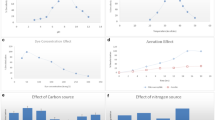Abstract
Four different aerobic mixed consortia collected from basins of wastewater streams coming out of dying plants of Crescent Textile (CT), Sitara Textile (ST), Chenab Fabrics (CF) and Noor Fatima Textile (NF), Faisalabad, Pakistan were applied for decolorization of Drimarene Orange K-GL, Drimarene Brilliant Red K-4BL, Foron Yellow SE4G and Foron Blue RDGLN for 10 days using the shake flask technique. CT culture showed the best decolorization potential on all dyestuffs followed by ST, NF and CF, respectively. CT could completely decolorize all dyes within 3–5 days. ST cultures showed effective decolorization potential on Foron Yellow SE4G and Drimarene Brilliant Red K-4BL but complete color removal was achieved after 4 and 7 days, respectively. NF culture showed 100% decolorization efficiencies on Foron Yellow SE4G and Foron Blue RDGLN but it took comparatively longer time periods (5–7 days). Where as, the NF culture had decolorized only 40% and 50% of Drimarene orange and red, respectively, after 10 days. CF caused complete decolorization of Foron Blue RDGLN and Drimarene Brilliant Red K-4BL after 4 and 8 days, respectively but it showed poor performance on other two dyes.
Similar content being viewed by others
References
Adedayo O, Javadpour S, Taylor C, Anderson WA, Moo-Young M (2004) Decolorization and detoxification of methyl red by aerobic bacteria from a wastewater treatment plant. World J Microbiol Biotechnol 20:545–550
Asgher M, Shah SAH, Ali M, Legge RL (2006a) Decolorization of some reactive textile dyes by white rot fungi isolated in Pakistan. World J Microbiol Biotechnol 22(1):89–93
Asgher M, Asad MJ, Legge RL (2006b) Enhanced lignin peroxidase synthesis by Phanerochaete Chrysosporium in solid state bioprocessing of a lignocellulosic substrate. World J Microbiol Biotechnol 22:449–453
Banat IM, Nigam P, Singh D, Marchant R (1994) Microbial decolorization of textile dye containing effluents. Biores Technol 58:217–227
Banat IM, Nigam P, Singh D, Marchant R (1996) Microbial decolorization of textile dye containing effluents: a review. Biores Technol 58:217–227
Boer CG, Obici L, de Souza CGM, Piralta RM (2004) Decolorization of synthetic dyes by solid state cultures of Lentinula (Lentinus) edodes producing manganese peroxidase as the main lignolytic enzyme. Biores Technol 94:107–112
Chagas EP, Durrant LR (2001) Decolorization of azo dyes by Phanerochaete chrysosporium and Pleurotus sajor-caju. Enz Microb Technol 29:473–477
Chung KT, Stevens SE Jr, Cernigliar CR (1992) The reduction of azo dyes by the intestinal microflora. CRC Crit Rev Microbiol 18:175–190
Chung KT, Stevens SE Jr (1993) Decolorization of azo dyes by environmental microorganisms and helminths. Environ Toxicol Chem 12:2121–2132
Cripps C, Bumps JS, Aust SD (1990) Biodegradation of azo and heterocyclic dyes by Phanerochaete chrysosporium. Appl Environ Microbiol 58:3605–3613
da Silva CG, Faria JL (2003) Photochemical and photocatalytic degradation of an azo dye in aqueous solution by UV irradiation. J Photochem Photobiol A: Chem 155:133–143
Hildenbrand S, Schmahl FW, Wodarz R, Kimmel R, Dartsch PC (1999) Azo dyes and carcinogenic aromatic amines in cell cultures. Int Arch Occupat Environ Health 72:52–56
Kirby N, Marchant R, McMullan G (2000) Decolorization of synthetic textile dyes by Phlebia tremellosa. FEMS Microbiol Lett 188:93–96
Knapp JS, Newby PS (1995) Decolorization of a chemical industry effluent by white rot fungi. Water Res 33:575–577
Liu S, Suflita JM (1993) Ecology and evolution of microbial populations for bioremediation. Trends Biotechnol 11:344–352
Levine WG (1991) Metabolism of azo dyes: implication for detoxification and activation. Drug Metab Res 23:253–309
Martins MAM, Queiroz MJ, Silvestre AJD, Lima N (2002) Relationship of chemical structure of textile dye on the␣preadaptation medium and the potentialities of their biodegradation by Phanerochaete chrysosporium. Res Microbiol 153:361–368
Moosvi S, Keharia H, Madamwar D (2005) Decolorization of textile dye ReactiveViolet 5 by a newly isolated bacterial consortium RVM 11.1. World J Microbiol Biotechnol 21:667–672
Nigam P, Banat IM, Marchant R (1996) Decolorisation of effluent from the textile industry by a microbial consortium. Biotech Lett 18:117–120
Okazaki S, Nagasawa S, Goto M, Furusaki S, Wariishi H, Tanaka H (2002) Decolorization of azo dye and anthraquinone dye in hydrophobic organic media using microperoxidase-11 entrapped in reverse micelles. Bioch Engin J.12:237–241
O’Neill C, Lopez A, Esteves S, Hawkes FR, Hawkes DL, Wilcox S (2000) Azo-dye degradation in an anaerobic–aerobic treatment system operating on simulated textile effluent. Appl Microb Biotechnol 53:249–254
O’Neill C, Hawkes FR, Hawkes DL, Lourenco ND, Pinheiro HM, Delee W (1999) Color in textile effluents: sources, measurement, discharge consents and simulation: a review. J Chem Technol Biotechnol 74:1009–1018
Pasti-Gragsby MB, Paszczynski A, Goszczynski S, Crawforg DL, Crawford RL (1992) Influence of aromatic substitution patterns on azo dye degrability by Streptomyces spp. and Phanerochaete chrysosporium. App Environ Microbiol 58:3605–3613
Quezada M, Linares I, Buitron G (2000) Use of sequencing batch biofilter for degradation of azo dyes (acids and bases). Water Sci Technol 42:329–336
Robinson T, McMullan G, Marchant R, Nigam P (2001) Remediation of dyes in textile effluent: a critical review on current treatment technologies with a proposed alternative. Biores Technol 77:247–255
Senan RC, Abraham TE (2004) Bioremediation of textile azo dyes by aerobic bacterial consortium. Biodegradation 15:275–280
Selvam K, Swaminathan K, Keo-Sang C (2003) Decolorization of azo dyes and a dye industry effluent by a white rot fungus Thelephora sp. Biores Technol 88:115–119
Synder CJP, Asgher M, Scharer JM, Legge RL (2006) Biodegradation kinetics of 2,4,6-Trichlorophenol by an acclimated mixed microbial culture under aerobic conditions. Biodegradation, Published on line: Feb.17, 2006; DOI 10.1007/s10532–005–9024–8
Verma P, Madamwar D (2003) Decolorization of synthetic dyes by a newly isolated strain of Serratia marcescens. World J Microbiol Biotechnol 19:615–618
Watanabe K, Baker PW (2000) Environmentally relevant microorganisms. J Biosci Bioeng 89:1–11
Wong PK, Yuen PY (1998) Decolorization and biodegradation of N,N-dimethyl-p-phenylenediamine by Klebsiella pneumoniae RS-13 and Acetobacter liquefaciens S-1. J Appl Microbiol 85:79–87
Author information
Authors and Affiliations
Corresponding author
Rights and permissions
About this article
Cite this article
Asgher, M., Bhatti, H.N., Shah, S.A.H. et al. Decolorization potential of mixed microbial consortia for reactive and disperse textile dyestuffs. Biodegradation 18, 311–316 (2007). https://doi.org/10.1007/s10532-006-9065-7
Received:
Accepted:
Published:
Issue Date:
DOI: https://doi.org/10.1007/s10532-006-9065-7




